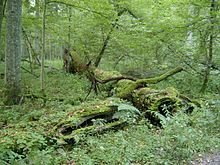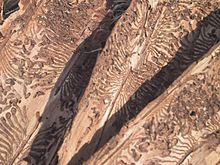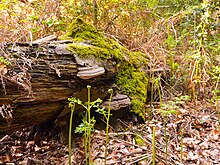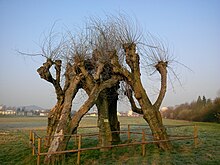Deadwood
Dead wood is used in ecology and especially in biotope and species protection as a collective term for dead trees or parts of them. A rough subdivision is made between standing deadwood, i.e. dead trees that have not yet fallen or parts thereof, and lying deadwood that is already on the ground.
The term deadwood is used here in a broader sense; As biotope wood , it also includes (small-scale) damaged, sick or dying trees, shrubs and their parts: standing dead wood is rarer, but usually offers a greater variety of location factors and is therefore ecologically more valuable than lying.
Occurrence, origin, forms of deadwood
In untouched primeval forests , large-volume dead wood is created by the death of the trees, catastrophic events ( forest fire , windthrow , lightning strike ), the massive occurrence of insects and other environmental influences (fluctuating groundwater levels etc.) (compare mosaic cycle concept and succession ). Small-volume dead wood arises in primeval as well as commercial forests mainly through competitive pressure in young stands. This leads to the death of poorly competitive trees as well as to the death of branches that no longer receive sufficient sunlight due to the tall trees.
Depending on the forest community, the proportion of dead wood in the total wood biomass in a primeval forest in Central Europe is 10–30 percent, in commercial forests this proportion is often only 1–3 percent.
Some examples - proportions for comparison
-
Tropical rainforest : The tropical rainforests have so far hardly been examined for their proportion of dead wood. In principle, however, there is a very high amount of deadwood, but also a much faster rotting with subsequent reinstallation in the living biomass.
- Australia's lowland rainforest: 20 - over 35 m³ / ha
- Forests of the temperate climate zone : In the cold climate zones, the rotting of deadwood takes much longer. While beech deadwood decomposes comparatively quickly, stronger fir and oak deadwood often remains for several decades.
- Finnish old forests: 19 m³ / ha (pine forest) - 60 m³ / ha (spruce forest)
- Poland, Białowieża Primeval Forest : 87–160 m³ / ha
- France, primeval forest reserve in the Fontainebleau forest : 142–256 m³ / ha
- Primeval beech forests of the Carpathian Mountains: 50–292 m³ / ha
- Montane mixed forest primeval forests in Slovakia and Slovenia: 80–568 m³ / ha
-
Germany :
- On average, there is 20.6 m³ of deadwood per hectare in German forests , which corresponds to about six percent of the living wood mass (336 m³ / ha). The average amount of dead wood in the individual federal states is between 11.0 m³ / ha ( Brandenburg / Berlin ) and 28.8 m³ / ha ( Baden-Württemberg ). In the period 2002–2012, the amount of dead wood in Germany increased by 2.1 m³ / ha.
- Old forest holy halls : 244 m³ / ha
Deadwood habitat

Dead wood with moss growth
|

Larval ducts of the printer
|
Deadwood is used by a large number of organisms that have adapted to this habitat in the course of evolution . Depending on the type of wood and degree of decomposition (state of the process of decay), around 600 species of large mushrooms and around 1350 species of beetles are involved in the complete remineralization of a wood body. There are various dependencies between fungi and insects. Insects transfer fungal spores to the wood body, which in turn can be a source of food and part of the habitat for insects.
, This results in that each dead wood type (whether horizontal or vertical stem crown wood or wood) with its own flora and fauna is associated. Life communities develop in the bark , in the wood , in the tree mole , in tree hollows and in special structures such as sap rivers , ant nests or burns .
Many animals and plants that depend on dead wood, are on the Red List of the extinction of endangered species. In their way of life, these species are highly dependent on certain phases of decay and decomposition of wood. Mushrooms , lichens , mosses , ferns and many species of insects , such as ants , hymenoptera and butterflies , find their habitat here. The majority of our 1000 wasps and bees are dependent on old and dead wood.
Selection of beetles in the deadwood
The importance of dead wood for species protection is particularly well documented in the case of beetles . Around 25 percent of all beetle species occurring in the Federal Republic of Germany live on wood in various stages of decay. The group of xylobiont beetles has a very high proportion of threatened species in Germany. Many of these species have special habitat requirements . There are specializations in terms of tree species, preferred structure ( bark , bast , heartwood ), wood volume, degree of decomposition, exposure to light, moisture, and fungal and insect infestation.
The stag beetle ( Lucanus cervus ) prefers predominantly deciduous trees . Its larvae live on rotten roots of old oaks , elms and fruit trees, less often on softwoods . A large number of longhorn beetle species (Cerambycidae) such as the great oak billy beetle ( Cerambyx cerdo ) are also dependent on hardwood. The fire beetles (Pyrochroidae) are located under the bark of dry dead wood, the larvae of these animals hunt bark beetles in the wood. Among other things, the larvae of the musk buck ( Aromia moschata ) live in softwoods such as willows .
Various jewel beetles (Buprestidae) and wrinkled beetle larvae (Rhysodidae) can be found in conifers . The house buck ( Hylotrupes bajulus ) has its natural habitat in dry spruce wood , the larvae of the spruce buck ( Monochamus sutor ) and the common spruce sapling buck ( Tetropium castaneum ) prefer the cambium of spruce and pine and pupate later inside the branches or the trunk. The Mulmbock ( Ergates faber ) prefers stumps of pine, but can also be found on spruce and fir trees in higher elevations .
However, many beetle taxa are also less specialized. The shamrock beetles (Oedemeridae) and their larvae can be found in terrestrial dead wood, but also in flotsam and in woody parts of herbaceous plants. The larvae of the rhinoceros beetle ( Oryctes nasicornis ) also develop in wood waste, in this country they are mainly found in compost heaps. Also on wood and other substrates are Thanasimus (Cleridae) to find. From the family of mold beetles (Latridiidae), Latridius lardarius in particular prefers moldy wood, it feeds on mold . Deadwood also provides winter quarters for a number of beetles, such as many ladybirds (Coccinellidae).
Selection of other insects in the dead wood
Dust lice feed on fungal tissue, spores , lichens and green algae and can be found under bark, on tree trunks and dead wood. Among the two-winged birds (Diptera) it is mainly representatives of the dung mosquitoes , hair mosquitoes and midges whose larval development takes place in musty dead wood. The larvae of the goblin flies also live in the dead wood and feed on tree fungi . Wooden flies hunt larvae and worms. The mason bees build their nests in crevices in dead wood and abandoned feeding programs of other insects. The wooden bee creates brood cells in dry, sun-exposed and slightly rotten dead wood and overwinters in the dead wood. The real wasps (Vespidae) need wood to build their nests and hang their structures in dry cavities of old trees. Many other wild bees , bumblebees and hornets live in dead logs, mostly in upright tree stumps.
Reptiles, birds and mammals in the deadwood
Deadwood offers larger animals the opportunity to create their burrows and nests and is a habitat for food for birds and other vertebrates. Woodpeckers and other native birds feed on the insect larvae in the wood . Woodpeckers rooms their nests in living as well as dead trees or tree parts. The tree cavities thus formed are when the woodpeckers have left it, used by other animals to nest, such as the owl species Raufußkauz , pygmy owl and tawny owl and the Dove or small mammals such as dormice and squirrels .
Also pine marten use the caves. Abandoned woodpecker holes also serve a number of bat species as the noctule , the Bechstein bat , the brown long-ear , the Frans bat and the water bat (in the vicinity of water, backwaters , Auwald ) as a summer and winter quarter.
Various amphibians and reptiles look for lying dead wood as a daytime hiding place (sunbathing) or for wintering. These include the common toad and the forest lizard, as well as the European pond turtle , which needs dead wood near water. Slow worms and adders seek out tree hollows close to the ground for wintering and as a nesting place. The slow worm uses old tree trunks to sunbathe during the day. The adder hides in or under dead wood during the day when it is very hot.
Mushrooms in the dead wood
Totholz is over years of bacteria , beetles and tree fungi such as the Zunderschwamm , the Armillaria and other so-called lignicolen decomposed fungi. The resulting humus becomes a breeding ground for plants. Deadwood also forms a seedbed for many young trees; its mass and distribution can influence the stand and forest structures that emerge after natural decay .
Microclimatic peculiarities of dead wood
Dead wood lying on the ground has a balancing effect on the microclimate in the immediate vicinity. On the one hand, the dark surface and the low thermal conductivity of wood mean that dead wood has a higher temperature than its surroundings at certain times . On the other hand, dead wood can also protect its immediate surroundings from overheating , as it is able to compensate for temperature fluctuations due to the increased water content . The latter is also the reason that the soil near lying dead wood dries out less quickly than in other places.
Deadwood in limnic and semiterrestrial ecosystems
Deadwood fulfills an important function not only in woody biotopes and terrestrial (land) ecosystems , but also in freshwater-influenced ecosystems ( limnic ecosystems) and semiterrestrial ecosystems such as moors and in swamp forests .
Effect of dead wood in running water
In the natural waters of Central Europe there is always a high proportion of deadwood in different forms due to the vegetation and has a strong influence on the appearance. In backwaters of streams to rivers and streams the natural is river dynamics by trees significantly influenced by dead wood and: by establishing banks, erosion reduction, flotsam and accumulation, by creating regions of different flow velocity or Verlandungs zones. The water accumulates on trunks and small debris and reduces the flow speed, which leads to the deposition of sediments . The deposited sediments reduce the digging of the running water ( see: bed load hunger); Deadwood also helps regulate the groundwater level . The damming effect can lead to a change in the current line and to a lateral shift, the meandering of the water is supported. However, there are also sections with a higher flow velocity (formation of pools ), steep banks and edges. Structural diversity ( water structure quality) and water quality are improved through oxygen enrichment ( self-cleaning power ).
Influence on the biocenosis in running waters
The occurrence of dead wood is considerable in natural waters. Even the smallest structural differences, such as trunk, branches, crown; The quantity of deadwood and the ratio of underwater and overwater deadwood are quality features.
The positive development of the fish populations has been proven in tests. In fish ecology studies, the rainbow trout population rose from 180 to around 500 in the first year after the artificial introduction of dead wood in poorly structured, canalized rivers, and in the second year to up to 1,100 individuals per 150 meter stretch of water. The greatest increase was found in the crown area of brought in dead trees, where the rainbow trout could spawn. The number of individuals also increased upstream and downstream of the enriched stretches of water.
In this case, the biodiversity of the fish communities has not increased due to other environmental damage (passability, water quality ). Nevertheless, it can be assumed that fish of other sizes as well as crustaceans , mussels , sessile and many other species also benefit from dead wood in rivers .
In the water, fallen dead wood is in itself a habitat is - so use about 60 native beetle species only such deadwood for egg tray, which was already in the water. Birds use wood protruding from the water as a hide. The bridge spider (a type of cross spider ) specializes in building webs on dead wood and other objects above water.
In the natural floodplains of flowing water, deadwood is the defining element. A lot of large-volume deadwood is found in alluvial forests , as the strongly fluctuating groundwater levels and regular floods cause trees to die at shorter intervals. If there is no management, the decay phase of the forests is widespread , especially due to periodic flooding . Hardwood and softwood meadows are often characterized by dying individual trees exposed to the sun; Together with lying dead wood, they offer a very species-rich habitat. In oxbow lakes , dead wood promotes silting through nutrient input and thus ensures stability and steady state of a stream .
Effect of dead wood in moors and swamp forests
In Bruchwald and swamp that is cyclic succession spread through the accelerated death.
In semi-terrestrial rain bogs and fens , dead wood makes a decisive contribution to the development of the typical location factors . In oxbow lakes and moors, fluctuating groundwater levels and climatic influences also cause deadwood to develop naturally. To a lesser extent, dead wood is also involved in bog formation .
Decline in stocks and social contexts
Due to the competition between ecological objectives and other human needs and demands for forests, parks and similar environments, most of the deadwood is usually removed or its formation is prevented. On the one hand, economic aspects play an important role here: Forestry is one of the most important employers in structurally weak regions. To protect (public or private) forest operations from damage caused by large-scale insect damage or forest fires, deadwood is only tolerated in limited quantities. Furthermore, standing dead wood may pose a considerable risk in terms of occupational safety when working in the forest.
In addition, landscape protection and its interaction with other social interests should be taken into account. National parks are often sought after in their condition and uniqueness, especially since tourism is usually the main source of income for these institutions. However, relevant aspects must also be taken into account in the area of local recreation in parks and forests. Standing dead wood is viewed critically with regard to the safety of those looking for relaxation, and aesthetic aspects are also important here.
In densely populated Germany, large-scale deadwood habitats have become rare overall. According to the state nature conservation laws, they are only explicitly protected in Saxony (“individual trees rich in caves” and “old wood islands rich in dead wood”). In all other federal states, dead wood biotopes as small structures do not fall under specially protected biotopes . A protection status in Germany usually only indirectly derive (z. B. orchard , hedgerows , hedges and field shrubs, swamp forests , habitats of threatened species of the Habitats Directive to achieve) or Individual or CLASSIFICATION DATES.
forestry

In Germany, in contrast to many other countries in the world, a holistic (inclusionist) approach to forestry (formerly the "wake theory") is traditionally pursued, in which all functions are to be performed simultaneously on one and the same economic area, i.e. economic and social benefits as well as all ecological functions , especially nature conservation. With this claim, a large part of the forest area in Germany is used for forestry without the forest laws operationally ensuring the three functions mentioned. This is at the same time the most important reason for the lack of strong deadwood and thus the main cause of the endangerment of the numerous species that rely on it. Regardless of the type of operation ( age-group forest or permanent forest ), most trees are used before they can naturally die of old age. This means that the phases of age and decay that are typical of a primeval forest are eliminated in many places. In particular, the crown and thickening closure that is constantly striven for in the age group forest , u. a. by afforestation of small clearings, the solar radiation and thus also the variety of different light mosaics and decomposition conditions is reduced. In particular, since the increased demand for forest wood as an energy source, wood assortments that were previously uneconomical to use in the forest are increasingly being used again, for example softwood, weak assortments such as branches and plaits , or fragile or fungal wood.
Historically, the forest was kept "clean" for a long time due to the need for fuel, since dead branches and tree remains had to be used as raw materials. Later, the view was partly adopted to prevent the "pests" living in dead wood, so that the view was often held until the 1990s that "the forest must be clean". In the course of the turn of some state forest operations to more natural forest management forms since the end of the 1980s, increasing attention was paid to the lack of dead wood structures in commercial forests. For the first time in Germany in 1992, the Saarland state forests issued a deadwood strategy, which bindingly instructed the forest services in public forests to permanently exclude at least five percent of the standing wood mass (over 30 cm diameter at chest height) from use as biotope trees. A deadwood recommendation is now also part of the federal government's biodiversity strategy, which, however, does not have direct legal competence in the federal system.
Since most of Germany's forests are managed, attempts are made to reconcile the interests of nature conservation and forestry in forest management plans or landscape plans . Due to its enormous importance for forest ecosystems, the presence of dead wood is a criterion for the certification of sustainable forestry . A small percentage of the area must be taken out of use ( FSC ), or there are guidelines for maintaining a minimum of strong dead trees ( PEFC ).
Tree maintenance in public and private green spaces
In public green spaces, especially on streets, and in private gardens, dead wood is usually removed because it is viewed as "ugly" or because it is required by road safety requirements. Courts usually award a claim for damages against the owner of a tree to those injured by falling branches. Gardening authorities and private individuals usually do not make use of the legal possibility of exempting themselves from this obligation in recreational areas (by means of appropriate signs: “Enter / drive at your own risk”) in order to avoid possible legal disputes.
Such a "form-based clearing" is not possible if a tree or branches fall onto a traffic route. Courts do not recognize a “form-based exemption” from liability through such signs. Hazardous areas can only be mitigated by eliminating the hazard or effectively blocking the area for public traffic.
However, § 60 BNatSchG limits this liability of the owners towards those seeking relaxation “on paths in the open corridor and unused properties”: recreational use is at your own risk. It is also becoming apparent that broken branches or tree falls in the existing forest are to be regarded as "typical forest" dangers for which the transport provider is not liable (similar to the case of "falling rocks on high mountain trails").
As a further measure to minimize the loss of habitat for rare animal species, removed deadwood trunks are rebuilt in places other than deadwood pyramids. This serves to further preserve strictly protected species.
Deadwood replacement habitats
In order to preserve all naturally occurring forest communities in Germany, it is necessary to dispense with management on representative areas. This is only partially realized even within the existing national parks. Therefore, within the framework of the National Biodiversity Strategy, 5% of the forest area in Germany is to remain permanently uncultivated.
Deliberately created nesting aids such as perforated bricks and incubators, logs on the balcony and in the garden can offer some species a substitute habitat. A settlement in the sense of an ecosystem with mammals and birds or even with specialized beetles cannot be achieved with it. Measures in forests, green spaces and gardens are more effective. Tree cuttings should not be removed or shredded. It can be used in the garden to create hedges that are rich in dead wood, similar to the Benjes hedge , as a privacy screen and design element. Sawn trunks can be leaned against or buried in the important standing dead wood.
literature
- LWF Leaflet 17: Biotope Trees and Deadwood . (PDF; 1.1 MB) Bavarian State Institute for Forests and Forestry (LWF), Freising 2014.
- Jiri Zahradnik: Beetles of Central and Western Europe . Paul Parey, Berlin 1985, ISBN 3-490-27118-1 .
- Specially protected biotopes in Saxony . Saxon State Office for Environment and Geology - Radebeul, materials for nature conservation and landscape management. Volume 2. Dresden 1992, 2nd edition 1995.
- Frank Köhler, Uta Schulte ( arr .): Deadwood beetles in natural forest cells of the northern Rhineland . Comparative studies on the deadwood beetle fauna in Germany and German natural forest research . Natural forest cells in North Rhine-Westphalia. Part 7. Series of publications by the State Institute for Ecology, Land Management and Forests, State Office for Agricultural Regulation North Rhine-Westphalia. Vol. 18. State Institute for Ecology, Land Management and Forests (LÖBF) / State Office for Agricultural Regulation North Rhine-Westphalia and Diakonisches Werk. Shaft tower, Recklinghausen 2000, ISBN 3-89174-031-X .
- www.totholz.ch
Web links
- Research report on deadwood beetle fauna in a natural oak forest reserve
- Deadwood dossier. waldwissen.net
- Old and dead wood concept Baden-Württemberg. waldwissen.net
- Deadwood: It's the quality that counts Federal Research Institute for Forests, Snow and Landscape (WSL), focus on forest reserves.
- Dead wood in the forest. Origin, meaning and promotion . (PDF; 7.7 MB) WSL information sheet for practice
- NABU project "Valuable forest through old and dead wood"
- Dead wood and running water
- Deadwood in running waters
Individual evidence
- ↑ Simon Grove: Extent and composition of dead wood in Australian lowland tropical rainforest with different management histories . James Cook University website, Townsville, Australia. Retrieved June 1, 2013.
- ^ Deadwood - living forests. WWF Report, Gland 2004.
- ↑ W. Gatter: Germany's forests and their bird communities in the context of social change and environmental influences In: Vogelwelt 125, 2004, pp. 151–176 (PDF)
- ↑ Other national parks for Germany ?! BfN, 2013 (PDF).
- ↑ National Forest Inventory 3, 2012 . Retrieved March 13, 2015.
- ↑ hydra-institute.com ( Memento from December 5, 2004 in the Internet Archive )
- ↑ Forestry framework guideline for the management of public forests in Saarland . Minister for Economic Affairs, Decree of Principle, Saarbrücken 1992, OCLC 46184892
- ↑ a b National Strategy on Biodiversity , adopted by the Federal Cabinet on November 7, 2007









